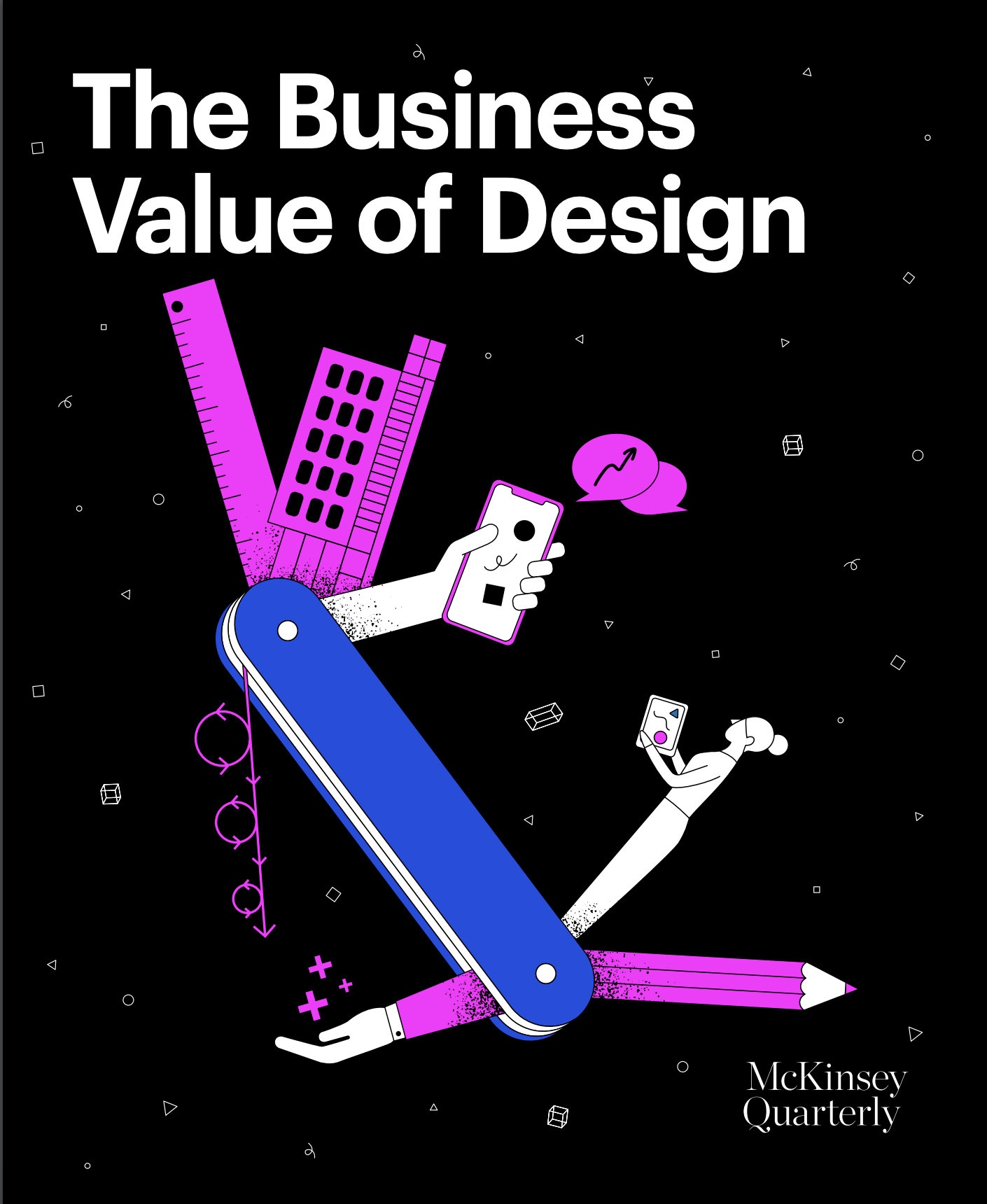McKinsey published an insightful report correlating the value of design in business, with increased revenues and shareholder returns. As I began reading I thought I would take some notes and share it here as a reminder to me, as well as businesses, that design wouldn’t work as a temporary measure. It has to be integrated holistically within the long-term growth opportunities of the company, which includes, nurturing top talent, investing in design infrastructure, senior management & C-suite engagement, and a culture of collaboration amongst cross-functional teams. In that, I can only cite Apple’s example of a continual focus on developing products which combine the theories of service design, hardware, and software, in producing assets of greater value
The Business Value of Design – McKinsey Design Report
- This is the most extensive and rigorous research undertaken by McKinsey to study actions that leaders could make in unlocking the business value using design.
- Companies like Amazon have demonstrated the obvious commercial benefits of designing great products and services, increasingly blurring the lines between hardware, software, and services. Today, companies need stronger design capabilities than ever before.
- So how do companies deliver exceptional designs and what the worth of design? McKinsey tracked the design practices of 300 publicly listed companies over a five-year period in multiple countries and industries, and interviewed senior design leaders.
- The companies were rated using the ‘McKinsey Design Index’ (MDI) demonstrating the insights correlating to their design capabilities and revenues.
- A high MDI score correlated to superior business performance. An increase in revenues and total returns to shareholders for the top-quartile MDI scorers.
- The results suggest “that good design matters whether your company focuses on physical goods, digital products, services, or some combination of these.”
- There are more opportunities for pursuing user-centric, analytically informed design today with customers & companies feeding opinions in real time with each other. Social media, for instance, offers faster access to real customers and also through smart devices allowing companies to place the user at the centre of business decisions.
Over 40 percent of the companies surveyed still aren’t talking to their end users during development. Just over 50 percent admitted that they have no objective way to assess or set targets for the output of their design teams. With no clear way to link design to business health, senior leader are often reluctant to divert scarce resources to design functions.
- McKinsey has categorised ’The Value of Design’ into 4 themes – Analytical leadership, Cross-functional talent, Continuous iteration and User experience. The top-quartile companies in the field of design and who are leading financial performers excelled in all four areas.
The following are some notes on the 4 themes that McKinsey defined as a value-add for business:
Analytical Leadership
- Companies that scored high on the MDI understood that design is a top-management issue, giving it equal importance as tracking revenues and costs. Companies with the best financial returns have combined design and business leadership through a bold, design-centric vision clearly embedded in the deliberations of their top teams.
- Design issues remain stuck in middle management, rarely rising to the C-suite
- Designers have not embraced design metrics or actively shown the management how their designs align with the business goals.
A strong vision that explicitly commits organizations to design for the sake of the customer acts as a constant reminder to the top team. The CEO of T-Mobile, for example, has a personal motto: “shut up and listen.” IKEA works “to create a better everyday life for the many people.” And as Pixar cofounder Ed Catmull told readers in a McKinsey Quarterly interview, to “wow” movie-goers continually, his company encourages its teams to take risks in their new projects: Pixar considers repeating the formulas of its past commercial successes a much greater threat to its long-term survival than the occasional commercial disappointment.
- Companies that performed well on the analytical leadership front maintained an understanding of customer needs among all executives, meaning, they bear a curiosity of user needs as opposed to what they say they want.
- Examples – a top team invites customers to its regular monthly meeting to discuss the merits of its products and services. A CEO of a large bank spends a day every month with the bank’s clients and encourages all members of the C-suite to do the same. Executives learn about customer pain-points & desires firsthand through this approach.
User Experience
- A full user experience is breaking down internal barriers between physical, digital, and the service design streams. User-centricity means a “broad-based view of where design can make a difference.” By combining physical products, digital tools, and services companies are able to capture a holistic range of experiences.
- Only 50 percent of the companies surveyed by McKinsey conducted user research before generating their first design ideas or specifications.
A hotel, for example, might do more than just focus on the time between check-in and check-out (the service element) by promoting early engagement through social media or its own apps (the digital dimension) and providing physical mementos aimed at encouraging customers to rebook. The reception team of one big hotel chain we know gives departing guests a rubber duck adorned with an image of their host city (such as clogs and tulips for Amsterdam). The team includes a note suggesting that guests might like to keep the duck at home as a reminder of their stay and could build a collection by visiting the group’s other properties. This small touch led to a 3 percent improvement in retention over time.
- The best businesses
think more broadly and don’t limit themselves to their own ecosystems. For instance, Google Pay and Apple Pay showed the willingness to devise easier ways to access cash digitally.
Cross-functional Teams
- Companies that made it to the top-quartile considered user-centric design as everyone’s responsibility, and not a siloed function. In contrast, the traditional design departments cut off the creative team from the rest of the organization. Bottomline, integrate designers with other functions.
- Top-quartile firms nurtured talent by incentivizing designers which are tied to design outcomes, such as user-satisfaction metrics or handing out major awards, although it’s not enough to retain top design talent if they’re not given the freedom to work on projects that stir their passion, given speaking opportunities at conferences, and opportunities to connect with the design community at large. Basically, building an autonomous design culture at work.
- “T-shaped” hybrid designers, those who work across varied functions yet are masters of a specialized skill, have the most impact through their work. However, they’d only be effective if they have the “right tools, capabilities, and infrastructure.”
- Design allocations, such as research, prototyping, or concept generation, should not become line items in the marketing or engineering budgets. But should be agreed to in partnership with design leaders.
Continuous Iteration
Design flourishes best in environments that encourage learning, testing, and iterating with users—practices that boost the odds of creating breakthrough products and services while simultaneously reducing the risk of big, costly misses. That approach stands in contrast to the prevailing norms in many companies, which still emphasize discrete and irreversible design phases in product development. Compartmentalization of this sort increases the risk of losing the voice of the consumer or of relying too heavily on one iteration of that voice.
- Development functions should not be vacuumed otherwise excellent work ends up wasted. The best results are obtained by constantly blending user research, such as qualitative and quantitative data, combined with other financial & analytical reports.
- An example of continuous iteration – at a medical company, where a physical product would be built by collaborating with a toy designer and a dating-app designer would inspire the design of digital interfaces. This not only helped the company refine the device which appealed to the “limited dexterity” of the consumers but also beat the market expectations. Bottomline, share early prototypes with outsides and celebrate embryonic ideas.
- Despite the value of iteration, almost 60 percent of companies in the McKinsey survey reported using prototypes only for internal-production testing & late in the development process.
- Product launch isn’t the end of an iteration cycle. Design-centric companies issue constant updates and continue to improve its products. For example, the Apple Watch.
Learning From The McKinsey Design Report
- Design excellence is within reach of every business, whether product, service, or digital oriented.
- Use an upcoming product or service as a pilot in getting the four elements right.
- Hire “T-shaped” designers, introduce appropriate incentive programs, but also provide the autonomy to choose their passion. Empower top talent in cross-functional teams that take collective accountability for UX improvements.
- Put the user experience in the center of the company’s culture, soften internal boundaries which don’t exist for the customers anyways.
- Iterate, test, and learn rapidly. And continue to incorporate user insights from “the first idea until long after the final launch”.



